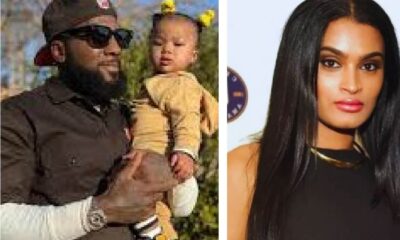Health
Barbara Roufs: Remembering the Iconic Face of 1970s Drag Racing

Barbara Roufs’ entrance into the American drag racing world came at a time when the sport was experiencing a cultural transformation. By the early 1970s, the image of drag racing was shifting from pure speed-focused mechanics to an era that embraced style, image, and marketing. Barbara became a central figure in this evolution, known not just for her beauty but for the confident presence she brought to racing events across California and beyond. She wasn’t just another model at the sidelines—Roufs became a symbol of the sport’s electric energy.
Her long flowing hair, towering boots, and dazzling smile captivated fans and racers alike. What separated Barbara Roufs from other promotional figures of her time was her authenticity. She wasn’t simply a prop beside the cars; she was genuinely engaged with the racing community and appreciated for her charisma. Her role as a trophy girl put her center-stage in photos, promotional materials, and magazine spreads that now define the visual legacy of 1970s drag racing.
Quick Bio
| Detail | Information |
| Full Name | Barbara Roufs |
| Date of Birth | 1944 |
| Place of Birth | California, United States |
| Ethnicity | Caucasian |
| Hair Color | Brown |
| Eye Color | Brown |
| Marital Status | Married |
| Parents | Thelma Ruby Riley & Wayne Eldon Riley |
| Siblings | Vivian Deaton, James, Bruce, Ben Gube |
| Children | Jet Dougherty |
| Profession | Trophy Girl and Model |
| Died | January 1991 |
| Age at Death | 47 years |
| Cause of Death | Suicide |
Beauty and Boldness: The Trophy Girl Who Redefined an Era
Barbara Roufs wasn’t just stunning—she embodied the bold aesthetic of 1970s counterculture. With her tall, slim figure and feathered hair, she brought a modern, liberated woman’s style into a male-dominated sport. At a time when women were often background figures, Barbara stood out as an empowered and unmissable presence.
Her fashion sense was as iconic as her personality. She wore mini skirts, crop tops, and go-go boots, outfits that turned heads and set trends. These weren’t random style choices; they reflected a cultural revolution that valued expression, freedom, and rebellion. Barbara’s presence in drag racing events infused the sport with a new level of coolness and drew mainstream attention from fashion photographers and lifestyle magazines.
How Barbara Roufs Became a 1970s Drag Racing Icon

Barbara Roufs became a star in the Southern California drag racing circuit—a hub of American car culture. She earned fame not only through live events but through the photographs that spread her image far beyond the race tracks. As photographers began documenting the vibrant scene, Barbara’s image appeared in countless magazines, posters, and memorabilia. Her iconic look—wind-swept hair, sunglasses, and a confident stance—quickly became synonymous with drag racing glamor.
Her fame peaked in the early to mid-1970s when the sport reached new commercial heights. Promoters began recognizing the value of female models and trophy girls in expanding racing’s appeal to wider audiences. Barbara Roufs was at the top of that wave, becoming the face of everything fast, flashy, and fashionable about the sport.
Behind the Spotlight: Barbara Roufs’ Personal Life
While her public persona sparkled with confidence, Barbara’s personal life was far more private and mysterious. She did not court media attention beyond her professional role and maintained a low profile off-track. She had a daughter, who later played a key role in preserving Barbara’s legacy by sharing personal photographs and memories after her death. However, details about Barbara’s relationships, family background, and emotional struggles remain limited and mostly speculative.
Her low-profile lifestyle off-track created a paradox—while millions knew her image, few truly knew the woman behind the smile. This separation between fame and personal life later contributed to the intrigue and speculation surrounding her tragic death.
The Tragic and Mysterious Death of Barbara Roufs

In 1991, Barbara Roufs died at the age of 47. Reports suggest she took her own life, though no official cause of death has been confirmed publicly. Her sudden passing stunned those in the racing community and her fans, who had admired her from afar during her peak years. Tragically, by the time of her death, she had already faded from the public eye, and many had lost touch with her story.
Her daughter later spoke about Barbara’s death and her struggle with life after the spotlight. The cultural shift in the 1980s left many 1970s icons, especially women whose fame was tied to beauty and youth, feeling forgotten. The loss of identity and purpose in the absence of fame is something many former public figures struggle with, and Barbara may have been no exception.
Legacy Through Lens: Rediscovery in the Digital Era
Decades after her death, Barbara Roufs experienced an unexpected resurgence in popularity. In the 2000s, classic drag racing photographers like Tom West began sharing their archives online, and images of Barbara resurfaced. Her striking poses, electric energy, and period-perfect style captivated a new generation of fans—many of whom had never witnessed the golden age of 1970s drag racing.
Social media platforms and retro car culture forums played a significant role in reviving her legacy. Barbara’s photographs began to circulate again, not as nostalgic pieces of memorabilia, but as cultural artifacts representing an era of fearless individuality. She was no longer just a pretty face; she was now remembered as a style icon, a trailblazer, and a tragic figure who embodied both the glory and sorrow of fame.
Why Barbara Roufs Still Matters Today

Barbara Roufs’ impact goes beyond vintage nostalgia. Her life story opens up important conversations about the role of women in male-dominated industries, the objectification of public figures, and the personal cost of fleeting fame. In many ways, she was ahead of her time—a woman who used her beauty not just as a tool, but as a weapon of visibility in an otherwise closed-off world.
Her story also underscores the importance of mental health support, especially for those navigating the highs and lows of fame. Barbara’s life is a reminder that what we see in photos doesn’t always reflect the emotional truths behind them.
Barbara Roufs in Pop Culture and Modern Tributes
In recent years, Barbara Roufs has been honored in documentaries, drag racing retrospectives, and photography exhibits. Classic car shows and motorsport history events often include her imagery as a nod to the culture she helped define. The renewed interest in retro motorsport photography has also inspired digital artists, fashion designers, and bloggers to reintroduce Barbara’s image to today’s aesthetic landscapes.
She has posthumously become a muse not only for drag racing historians but also for those exploring gender roles in sports and media. Through every shared photo, Barbara continues to influence fashion, nostalgia, and appreciation for the unique personalities who shape subcultures.
Family and Fans Keep the Memory Alive

Barbara Roufs may have passed decades ago, but her memory is lovingly preserved by her family and loyal fans. Her daughter’s decision to release photos and stories helped humanize a woman once frozen in time by glossy prints. Fans continue to share their admiration online, creating digital scrapbooks, tribute posts, and discussions about her life and death.
In forums dedicated to drag racing history, Barbara is remembered not just as a trophy girl, but as a symbol of a vibrant, rebellious, and creative era. Her story resonates because it is not only about beauty and speed—it’s about struggle, mystery, and the powerful human desire to be seen and remembered.
Conclusion: The Woman Behind the Legend
Barbara Roufs will forever be remembered as more than just a face in racing posters. She represented a moment in time when drag racing was wild, loud, and alive—and she brought her own kind of magic to that world. Her death, while tragic, has opened the door to a more profound understanding of the cost of fame and the importance of honoring those who make cultural history, even when their names are forgotten for a time.
Barbara Roufs’ story is one of beauty, fame, struggle, and rediscovery—a story that deserves to be told again and again.
Frequently Asked Questions (FAQs)
1. Who was Barbara Roufs?
- Barbara Roufs was a famous trophy girl and drag racing icon from the 1970s, known for her glamorous presence in the Southern California racing scene.
2. What was Barbara Roufs known for?
- She was widely recognized for her beauty, unique style, and her role as a prominent promotional figure during the golden age of drag racing.
3. How did Barbara Roufs die?
- Barbara Roufs reportedly died by suicide in 1991 at the age of 47, though the exact circumstances of her death remain largely private.
4. Why is Barbara Roufs considered a drag racing legend?
- She symbolized the vibrant culture of 1970s drag racing and became a poster icon through her numerous magazine features and promotional appearances.
5. How is Barbara Roufs remembered today?
- She is celebrated through vintage drag racing photographs, social media tributes, and renewed interest in retro motorsport culture.

-

 Celebrity7 months ago
Celebrity7 months agoThe Private World of Marina Pearl LeBlanc, Matt LeBlanc’s Only Child
-

 Life Style11 months ago
Life Style11 months agoWho is Amra Nor Jenkins? The Untold Story About Jeezy’s Daughter
-

 Entertainment11 months ago
Entertainment11 months agoWhat is Shoujo Ramune? The Comprehensive Guide
-

 Celebrity1 year ago
Celebrity1 year agoThe Untold Truth of William Mapel: A Deep Dive into His Personal Life
-

 News1 year ago
News1 year agoRanch World Ads Review: Everything You Need to Know
-

 Celebrity1 year ago
Celebrity1 year agoWho Is Stephanie Sarkisian? All You Need To Know AboutSteve Sarkisian’s Ex-Wife
-

 Celebrity1 year ago
Celebrity1 year agoThe Untold Story of Denika Kisty: Her Family, Net Worth, and More
-

 Life Style11 months ago
Life Style11 months agoJill Wagner Accident: Life and Health After Accident











